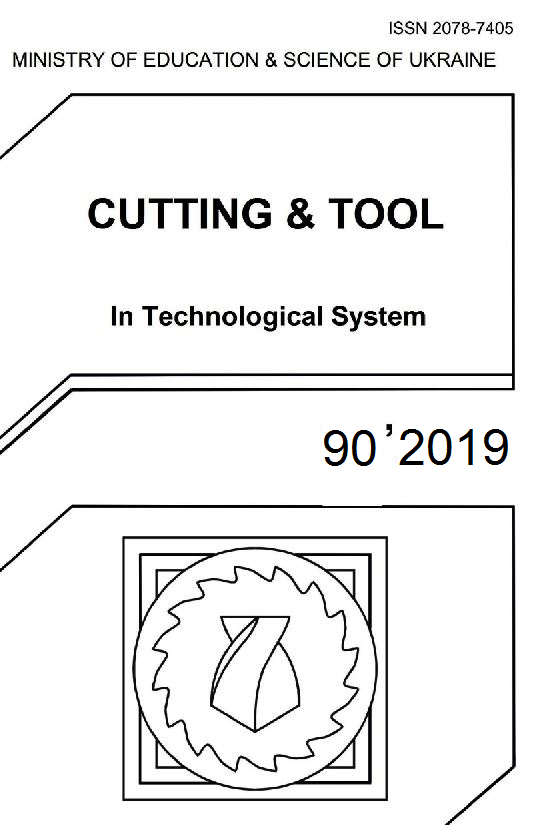JOINT MACHINING: HARD TURNING AND GRINDING
DOI:
https://doi.org/10.20998/2078-7405.2019.90.05Keywords:
hard turning, grinding, hybrid machining, machining efficiency, surface roughness, roundness, cylindricity.Abstract
The manufacturing of increasingly complex components and, at the same time, production of parts of superior quality is a growing trend in industry today. This tendency is realized through advanced machining processes that take advantage of the capabilities of the new machine tools, the properties of cutting tools and the advancements in control and CAD/CAM/CAE systems available today. However, productivity is important and it is not always possible to reduce machining times, while difficult-to-cut materials, successive processes and tool replacements hinder the desired goal. However, ready-machining of the components is a feasible way to achieve the aforementioned requirements. A possibility for this is machining the workpieces on one machine tool, with only one clamping. The fulfilment of the processing and finishing of parts with one clamping and the application of several processes, i.e. hard turning and grinding, in one machine tool is called joint or combined machining. There are several advantages to this arrangement in manufacturing processes, which are discussed in this paper.References
Lütjens, P.: Große Vorteile durch Kombinationsbearbeitung. Werkstatt und Betrieb 9, 2008, pp.114–120.
Weinert, K., Inasaki, I., Sutherland, J.W., Wakabayashi, T.: Dry Machining and Minimum Quantity Lubrication. CIRP Annals 53(2), 2004, pp. 511–537.
Varga, G.: Investigation of 3D Surface Roughness on Environmentally Friendly Way Milled Surfaces, Rezanie i Instrumenty v Tekhnologicheskih Sistemah 81 2012, pp. 24–33.
Varga, G., Szigeti, F., Dezső, G.: 3D Surface Topography Analysis of Environmentally Consciously Drilled Holes, Annals of Faculty of Engineering Hunedoara - International Journal of Engineering XI(3), 2013, pp. 99–104.
Kundrák, J., Gyáni, K., Felhő, C., Markopoulos, A.P., Deszpoth, I.: Analysis of lead twist in modern high-performance grinding methods. IOP Conference Series: Materials Science and Engineering 161, 2016, 012005.
Kundrák, J., Markopoulos, A.P., Makkai, T.: Assessment of tool life and wear intensity of CBN tools in hard cutting. Key Engineering Materials 686, 2016, pp. 1–6.
Karpuschewski, B., Wehmeier, M., Inasaki, I.: Grinding Monitoring System Based on Power and Acoustic Emission Sensors. CIRP Annals 49(1), 2000, pp. 235–240.
Byrne, G., Dornfeld, D., Denkena, B.: Advancing Cutting Technology. CIRP Annals 52(2), 2003, pp. 483–507.
Kundrák, J., Mamalis, A.G., Markopoulos, A.: Finishing of Hardened Boreholes: Grinding or Hard Cutting? Materials and Manufacturing Processes 19(6), 2004, pp. 979–993.
Kundrák, J., Mamalis, A.G., Gyani, K., Markopoulos, A.: Environmentally Friendly Precision Machining. Materials and Manufacturing Processes 21(1), 2006, pp. 29–37.
Sztankovics, I., Kundrák, J.: The characteristic parameters of the twist structure on cylindrical surfaces machined by turning procedures. Applied Mechanics and Materials 693, 2014, pp. 418–423.
Moriwaki, T.: Multi-functional machine tool. CIRP Annals 57(2), 2008, pp. 736–749.
Downloads
Published
Issue
Section
License
Copyright Notice
Authors who publish with this Collection agree to the following terms:
1. Authors retain copyright and grant the Collection right of first publication with the work simultaneously licensed under a Creative Commons Attribution License that allows others to share the work with an acknowledgement of the work's authorship and initial publication in this Collection.
2. Authors are able to enter into separate, additional contractual arrangements for the non-exclusive distribution of the Collection's published version of the work (e.g., post it to an institutional repository or publish it in a book), with an acknowledgement of its initial publication in this Collection.
3. Authors are permitted and encouraged to post their work online (e.g., in institutional repositories or on their website) prior to and during the submission process, as it can lead to productive exchanges, as well as earlier and greater citation of published work.

